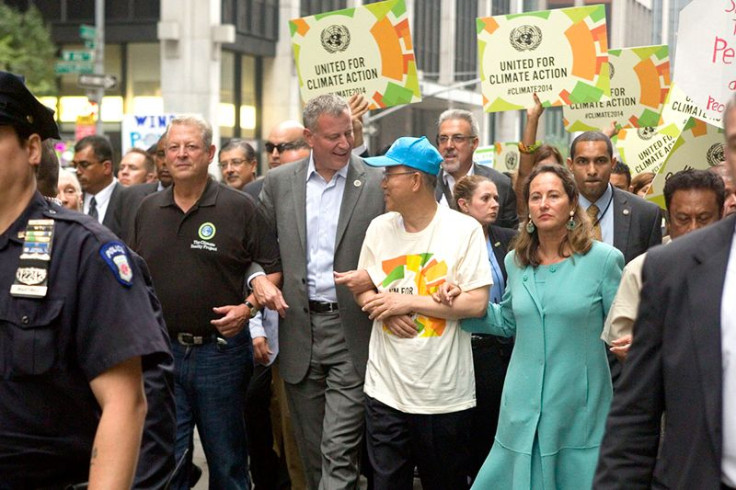Climate Change Threat: As Global Leaders Stall, Cities Move To Cut Emissions, Boost Efficiency

In the face of global and federal paralysis on climate-change policy, local officials in the U.S. are already moving to cut their cities’ emissions and make their infrastructures less vulnerable to environmental threats. In Dubuque, Iowa, municipal leaders are rolling out data technology to help residents use less water and electricity. In Philadelphia, city experts are restoring watersheds and planting gardens to soak up the residue of heavier rains and rising sea levels, both effects related to global warming.
However, few cities are doing more to confront climate change than New York, where Mayor Bill de Blasio appears keen to build on the environmental agenda of his predecessor, Michael R. Bloomberg. Before joining 400,000 people in at the People’s Climate March in Manhattan Sept. 21, de Blasio announced a far-reaching plan to reduce the city’s greenhouse-gas emissions over the next four decades to levels that would be 80 percent below the comparable marks in 2005.
“Climate change is an existential threat to New Yorkers and our planet,” de Blasio said in a statement, citing rising sea levels, heat waves and increasingly frequent storms such as the devastating Superstorm Sandy in 2012. “Acting now is nothing short of a moral imperative.”
Much of New York’s latest climate strategy is geared toward slashing electricity use in skyscrapers, office towers and sprawling apartment complexes. In this dense urban landscape, buildings account for nearly three-quarters of the city’s total greenhouse-gas emissions versus about 30 percent nationwide, making the structures the best places for the deepest carbon cuts.
So-called energy-efficiency measures in buildings can encompass mundane but effective fixes such as sealing window panes to block air drafts, layering thick insulation in the walls and swapping older light bulbs and ventilation systems with sleeker models. Steps also include modern solutions such as installing solar panels on rooftops, deploying data sensors to monitor consumption and using responsive systems that turn off lights and air conditioners when people exit the room.
If every city worldwide adopted such fixes, global emissions could drop by as much as 4.5 gigatons by 2050 -- the equivalent of cutting two-thirds of annual U.S. emissions, according to a new report presented by Bloomberg, who became a United Nations special envoy for cities and climate change after his third mayoral term ended in December.
“Globally, the greatest opportunity for mayors to reduce greenhouse-gas emissions is in urban building energy use,” Bloomberg said in a letter last week to U.N. Secretary-General Ban Ki-moon.
Accelerating Energy Efficiency
In de Blasio’s plan, a key component for achieving deep emissions cuts is the retrofit accelerator, which aims to pick up the pace of energy-saving overhauls in some of New York’s largest private buildings.
The program is modeled after the city’s 2011 Clean Heat initiative to cut air pollution from heating oil. Before the Clean Heat program, the city had adopted regulations to phase out diesel fuels in favor of cleaner alternatives, including natural gas. But many building owners couldn’t afford the expensive system upgrades, and others were paralyzed by engineering and regulatory barriers. Meanwhile, New Yorkers continued using heating oil and spewing harmful particulate matter into the air.
With Clean Heat, the city brought together city officials, regulators, engineers, real-estate groups and lending institutions to help owners navigate the red tape and secure lower-cost loans. Nearly four years later, some 4,000 of the city’s largest buildings have made the switch, said Andy Darrell, the New York regional director at the Environmental Defense Fund, which helped create the program.
As a result, particulate-matter pollution has dropped by 50 percent, and sulfur-dioxide pollution has fallen by nearly 70 percent, Darrell said in an interview. The program has since been replicated in other cities in the U.S. and abroad.
With energy efficiency, building owners face a similar set of challenges. New York has a wide array of efficiency programs and laws but, in practice, private property owners have found them burdensome and confusing. While the city offers incentives to help offset some of the capital costs, navigating the system is tricky, according to industry experts.
Through the retrofit accelerator, the city aims to upgrade 20,000 private buildings, which make up about 15 percent of all the square footage in New York’s buildings. The city will also devote at least $1 billion in capital funding to retrofit city-owned buildings over the next decade.
The Real Estate Board of New York, which has occasionally pushed back against the city’s green regulations, said it welcomed the plan.
The retrofit initiative could lead to similar programs in different cities, just as Clean Heat did, Darrell said. “It could very easily be adopted in other municipalities."
Another retrofit program is already under way. At the U.N. summit last week, the new District Energy in Cities Initiative launched an efficiency accelerator platform that aims to help municipal and national governments retrofit buildings and develop local energy infrastructure, as announced by Danfoss, a Danish maker of efficiency-related components and services.
Almost 20 cities have shown interest in the program, said Lars Tveen, who co-chairs the initiative and is president of district energy at Danfoss. These cities include London and Paris, as well as St. Paul, Minn.; Vancouver, B.C.; Jinan, China; Seoul, South Korea; and Nairobi, Kenya. Tveen said he and others will be watching New York’s accelerator to glean any insights for their own programs.
“What we see is that city governments are saying, ‘We want to make a difference,’” Tveen said.
© Copyright IBTimes 2024. All rights reserved.





















